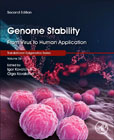
Genome Stability: From Virus to Human Application, Second Edition, a volume in the Translational Epigenetics series, explores how various species maintain genome stability and genome diversification in response to environmental factors. Here, across thirty-eight chapters, leading researchers provide a deep analysis of genome stability in DNA/RNA viruses, prokaryotes, single cell eukaryotes, lower multicellular eukaryotes, and mammals, examining how epigenetic factors contribute to genome stability and how these species pass memories of encounters to progeny. Topics also include major DNA repair mechanisms, the role of chromatin in genome stability, human diseases associated with genome instability, and genome stability in response to aging. This second edition has been fully revised to address evolving research trends, including CRISPRs/Cas9 genome editing; conventional versus transgenic genome instability; breeding and genetic diseases associated with abnormal DNA repair; RNA and extrachromosomal DNA; cloning, stem cells, and embryo development; programmed genome instability; and conserved and divergent features of repair. This volume is an essential resource for geneticists, epigeneticists, and molecular biologists who are looking to gain a deeper understanding of this rapidly expanding field, and can also be of great use to advanced students who are looking to gain additional expertise in genome stability. A deep analysis of genome stability research from various kingdoms, including epigenetics and transgenerational effectsProvides comprehensive coverage of mechanisms utilized by different organisms to maintain genomic stabilityContains applications of genome instability research and outcomes for human diseaseFeatures all-new chapters on evolving areas of genome stability research, including CRISPRs/Cas9 genome editing, RNA and extrachromosomal DNA, programmed genome instability, and conserved and divergent features of repair INDICE: 1. Genome stability - an evolutionary perspective I. Genome Instability of Viruses 2. Genetic Instability of RNA Viruses 3. Genome instability in DNA viruses II. Genome instability in Bacteria and Archaea 4. Genome instability in bacteria and archaea: Strategies for maintaining genome stability 5. Genome instability in bacteria: causes and consequences 6. CRISPR - bacteria immune system III. Genome Stability of Unicellular Eukaryotes 7. Programmed DNA rearrangement in ciliates 8. Homologous Recombination and Non-homologous End-joining repair in yeast IV. Genome stability in multicellular eukaryotes 9. Meiotic and Mitotic Recombination: First in Flies 10. Genome stability in Drosophila - mismatch repair and genome stability 11. Genome stability in Caenorhabditis elegans 12. Genetic Engineering of Plants using Zn-fingers, TALENs and CRISPRs 13. Plant Genome Stability - General Mechanisms V. Genome stability in mammals 14. Cell cycle control and DNA damage signalling in mammals 15. The role of p53/p21/p16 in DNA damage signalling and DNA repair 16. Roles of RAD18 in DNA Replication and Post-Replication Repair (PRR) 17. Base Excision Repair and Nucleotide Excision Repair 18. DNA Mismatch Repair in Mammals 19. Repair of double strand breaks by non-homologous end joining; its components and their function 20. Double-Strand Break Repair: Homologous Recombination in Mammalian Cells 21. Telomere maintenance and genome stability 22. The relationship between checkpoint adaptation and mitotic catastrophe in genomic changes in cancer cells 23. Chromatin, nuclear organization and genome stability in mammals 24. Role of DNA methylation in genome stability 25. Non-coding RNAs in genome integrity VI. Human diseases associated with genome instability 26. Human diseases associated with genome instability 27. Cancer and genomic instability 28. Chromatin Modifications in DNA Repair and Cancer 29. Genomic Instability and Aging - Causes and Consequences 30. Nucleolar contributions to DNA damage response and genomic (in)stability in the nervous system VII. Effect of environment on genome stability 31. Diet and nutrition 32. Chemical mutagenesis 33. Environmental sources of ionizing radiation and their health consequences Section VIII. Bystander and transgenerational effects - epigenetic perspective 34. Epigenetics of transgenerational genome instability in mammals 35. Genomic Instability and the Spectrum of Response to Low Radiation Doses 36. Transgenerational genome instability in plants 37. Methods for the detection of DNA damage 38. Conserved and divergent features of DNA repair. Future perspectives in genome instability research
- ISBN: 978-0-323-85679-9
- Editorial: Academic Press
- Encuadernacion: Rústica
- Páginas: 784
- Fecha Publicación: 01/08/2021
- Nº Volúmenes: 1
- Idioma: Inglés
